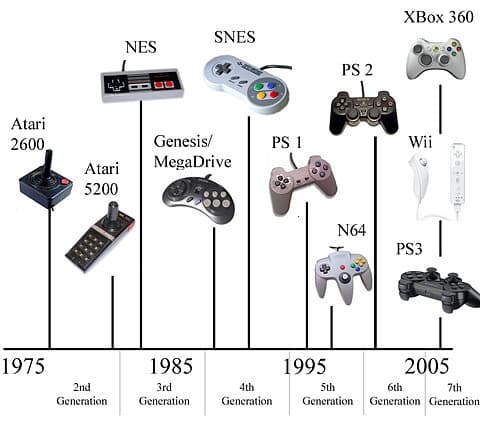Gaming has come a long way since its early days, evolving from simple pixelated screens to immersive, lifelike experiences. From the primitive 8-bit graphics of the 1980s to today’s stunning 4K resolutions, the evolution of gaming technology is nothing short of remarkable. For gamers, this journey has been filled with advancements in graphics, gameplay, and consoles that have fundamentally changed the way we interact with virtual worlds. In this post, we’ll explore the key milestones in gaming’s evolution, with a focus on how these improvements have shaped the gaming landscape.
The 8-Bit Era: Where It All Began
The 8-bit era, defined by consoles like the Nintendo Entertainment System (NES) and Sega Master System, was where gaming truly began to take off. Released in the 1980s, these systems brought arcade-style gaming into the home for the first time. While primitive by today’s standards, 8-bit graphics were revolutionary at the time, allowing developers to create simple but colorful characters and environments.
Despite the limited graphical capabilities, 8-bit games relied heavily on creativity and gameplay mechanics to draw players in. Titles like Super Mario Bros., The Legend of Zelda, and Final Fantasy became cultural icons not because of their visual fidelity, but because of their engaging mechanics and innovative level design. In this period, gameplay was often prioritized over visuals, creating an era where mastering mechanics was essential for progress.
The Rise of Pixel Art
8-bit games established a visual style that became iconic in its own right—pixel art. With each pixel clearly visible, developers had to be extremely inventive to create detailed environments and characters within these constraints. This minimalism birthed a genre of gaming art that remains beloved by indie developers and retro gaming fans today. Pixel art wasn’t just a necessity; it became a defining aesthetic for the era.
The 16-Bit Revolution: More Power, More Possibilities
The transition from 8-bit to 16-bit in the late 1980s and early 1990s marked a significant leap in the evolution of gaming technology. Consoles like the Super Nintendo Entertainment System (SNES) and Sega Genesis introduced a higher level of detail, allowing for richer environments and more complex character animations. This was the era when gaming began to flex its graphical muscles.
With 16-bit technology, the pixelated look of the 8-bit era became smoother, and more colors could be displayed on-screen at once. Iconic franchises like Sonic the Hedgehog and Street Fighter II flourished during this time, taking advantage of the enhanced graphics and more fluid gameplay. For gamers, the jump to 16-bit felt like a quantum leap in what was possible on home consoles.
Parallax Scrolling and Layered Backgrounds
One of the most impressive innovations of the 16-bit era was parallax scrolling, where different layers of the background would move at varying speeds to create a sense of depth. Games like Super Mario World and Donkey Kong Country used this technique to add a new level of immersion. Layered backgrounds gave a 2D game the illusion of a three-dimensional world, helping gamers feel like they were venturing through rich, detailed environments.
3D Graphics: A New Dimension in The Evolution of Gaming
The mid-1990s brought the next major evolution of gaming: the transition to 3D gaming. Consoles like the Sony PlayStation and Nintendo 64 pioneered the use of 3D graphics, offering a completely new way to experience games. Instead of navigating a flat world, players could now move through fully realized 3D environments.
Games like Super Mario 64 and Final Fantasy VII showed how this new technology could dramatically change the gaming experience. Super Mario 64 was particularly groundbreaking, allowing players to explore vast, open levels from all angles. The freedom to move in three dimensions opened up possibilities for new types of gameplay, making platformers and action-adventures more dynamic than ever before.
The Birth of Analog Controller
3D games required a new kind of controller. Enter analog sticks, which allowed for more precise control of characters in a 3D space. The Nintendo 64’s controller, with its innovative analog stick, became the blueprint for modern gaming controllers. Gamers could now navigate 3D environments smoothly, pushing the evolution of gaming further into immersive experiences.

The HD Era: Crisp, Detailed Worlds
The early 2000s marked the dawn of the high-definition (HD) era. Consoles like the Xbox 360, PlayStation 3, and later the Wii U embraced HD technology, allowing games to be rendered in 720p and 1080p resolutions. This was the point when graphical realism became a central focus of game development. Developers could now render highly detailed textures, realistic lighting, and lifelike character models.
Games like Grand Theft Auto and Elder Scrolls showcased the possibilities of HD graphics, with environments that felt rich and tangible. This leap in graphical fidelity was paired with increasingly complex game mechanics, creating a more cinematic experience for players. As games became more visually stunning, storytelling also took center stage, with rich narratives being woven into these high-definition worlds.
The Rise of Online Multiplayer
The HD era brought about the rise of online gaming, with platforms like Xbox Live and PlayStation Network enabling players to compete and collaborate across the globe. This shift allowed for seamless multiplayer experiences that extended far beyond local play, connecting gamers regardless of their physical location. For many, the social aspect of gaming became just as vital as the games themselves, reshaping how people interacted with gaming content.
One of the most significant milestones in the evolution of gaming has been the integration of online play, which transformed gaming into a global, real-time social experience. Titles like SOCOM and Call of Duty redefined multiplayer gaming, making online interaction a central feature of modern consoles. This advancement not only enhanced gameplay but also fostered a dynamic and immersive community-driven environment, solidifying online gaming’s role in shaping the future of gaming.
The 4K Era: The Pinnacle of Visual Fidelity
Today, we find ourselves in the 4K era, where gaming has reached new heights in both resolution and performance. Consoles like the PlayStation 5, Xbox Series X, and high-end gaming PCs offer 4K resolution with enhanced graphical effects like ray tracing, which simulates realistic lighting and shadows.
4K gaming isn’t just about more pixels—it’s about creating more immersive and detailed worlds than ever before. In titles like Fallout 76 and Elden Ring, the level of visual fidelity is staggering, with realistic reflections, highly detailed textures, and dynamic weather systems that make you feel like you’re inside the game. These advancements are not limited to visuals, as improved processing power allows for faster load times and more complex gameplay systems.
Virtual Reality (VR) and Beyond
While 4K is the pinnacle of traditional gaming, new technologies like virtual reality (VR) are pushing the boundaries even further. VR headsets like the Oculus Quest and PlayStation VR bring a level of immersion previously only dreamed of. In a VR game, you’re not just controlling a character on a screen—you’re physically present in the game world. This represents the next frontier in gaming technology, blending the line between reality and virtual experiences.

The Future: What’s Next for The Evolution of Gaming?
Looking forward, gaming technology will continue to evolve at a rapid pace. With the increasing integration of AI, procedural generation, and cloud gaming, the future of gaming looks incredibly exciting. We might see even more lifelike graphics, smarter NPCs, and seamless online experiences powered by cloud servers. The gaming industry has proven time and again that it can surprise us, and as 8-bit turned into 4K, we can only imagine what the future holds for the evolution of gaming.

The evolution of gaming from 8-bit to 4K is a testament to how far technology has come in just a few decades. For gamers, each new era has brought fresh innovations, changing the way we play, interact, and experience virtual worlds. As technology continues to advance, the future of gaming looks more exciting than ever, and I can’t wait to see what’s next.





